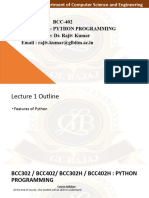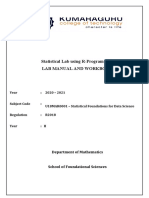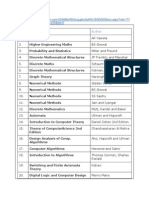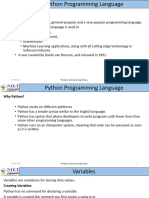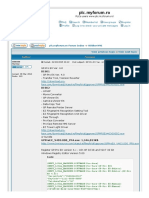Data Structure Using Python
Uploaded by
amanchauhan2603Data Structure Using Python
Uploaded by
amanchauhan2603GATE in Data Science and AI study material
GATE in Data Science and AI Study Materials
Data Structures using Python
By Piyush Wairale
Instructions:
• Kindly go through the lectures/videos on our website www.piyushwairale.com
• Read this study material carefully and make your own handwritten short notes. (Short
notes must not be more than 5-6 pages)
• Attempt the question available on portal.
• Revise this material at least 5 times and once you have prepared your short notes, then
revise your short notes twice a week
• If you are not able to understand any topic or required detailed explanation,
please mention it in our discussion forum on webiste
• Let me know, if there are any typos or mistake in study materials. Mail
me at piyushwairale100@gmail.com
For GATE DA Crash Course, visit: www.piyushwairale.com
GATE in Data Science and AI study material
1 Data Structures in Python
Data Structures are a way of organizing data so that it can be accessed more efficiently
depending upon the situation. Data Structures are fundamentals of any programming lan-
guage around which a program is built. Python helps to learn the fundamental of these data
structures in a simpler way as compared to other programming languages.
1.1 Built-In Data Structures
• Built-in data structures in Python can be divided into two broad categories: mutable
and immutable.
• Mutable data structures are those which we can modify – for example, by adding,
removing, or changing their elements. Python has three mutable data structures: lists,
dictionaries, and sets.
• Immutable data structures, on the other hand, are those that we cannot modify after
their creation. The only basic built-in immutable data structure in Python is a tuple.
1.1.1 List
• Lists are dynamic, ordered collections of elements that can hold items of various data
types, including numbers, strings, and even other lists. Their defining feature is their
ability to be modified, expanded, or reduced during program execution. This versatility
makes lists immensely useful for scenarios where data needs to be managed flexibly.
• Lists are created using square brackets, and elements within them are separated by
commas.
• Lists are mutable, ordered sequences of elements in Python. Declared using square
brackets [ ].
• List items are ordered, changeable, and allow duplicate values.
For GATE DA Crash Course, visit: www.piyushwairale.com
GATE in Data Science and AI study material
• List items are indexed, the first item has index [0], the second item has index [1] etc.
• When we say that lists are ordered, it means that the items have a defined order, and
that order will not change. If you add new items to a list, the new items will be placed
at the end of the list.
• The list is changeable, meaning that we can change, add, and remove items in a list
after it has been created.
1.1.2 Operations:
1. Creation:
my_list = [1, 2, 3, ’a’, ’b’]
2. Accessing Elements:
• Indexing: my list[0] returns the first element.
• Slicing: my list[1:3] returns a sublist from index 1 to 2.
3. Adding Elements:
• my list.append(4) adds 4 to the end.
• my list.insert(1, ’x’) inserts ’x’ at index 1.
4. Removing Elements:
• my list.remove(’a’) removes the first occurrence of ’a’.
• my list.pop(2) removes the element at index 2.
5. Other Operations:
• len(my list) returns the length.
• my list + [5, 6] concatenates lists.
For GATE DA Crash Course, visit: www.piyushwairale.com
GATE in Data Science and AI study material
1.2 Tuples
• Tuples resemble lists in that they are ordered collections of elements, but they have a
significant difference: they are immutable, meaning their content cannot be changed
after creation.
• Tuples are defined using parentheses, and elements are separated by commas.
• Tuples are immutable, ordered sequences. Declared using parentheses ( ).
• Tuple items are ordered, unchangeable, and allow duplicate values.
• Tuple items are indexed, the first item has index [0], the second item has index [1] etc.
• When we say that tuples are ordered, it means that the items have a defined order,
and that order will not change.
• Tuples are unchangeable, meaning that we cannot change, add or remove items after
the tuple has been created.
1.2.1 Operations:
1. Creation:
my_tuple = (1, 2, ’a’, ’b’)
2. Accessing Elements: Similar to lists, using indexing and slicing.
3. Immutable Nature: Elements cannot be added or removed after creation.
For GATE DA Crash Course, visit: www.piyushwairale.com
GATE in Data Science and AI study material
1.3 Sets
• Set items are unordered, unchangeable, and do not allow duplicate values.
• Sets are unordered collections of unique elements. Declared using curly braces { } or
set().
• Set items are unordered, unchangeable, and do not allow duplicate values.
• Set items are unchangeable, meaning that we cannot change the items after the set
has been created.
• Once a set is created, you cannot change its items, but you can remove items and add
new items.
• Sets cannot have two items with the same value.
1.3.1 Operations:
1. Creation:
my_set = {1, 2, 3, ’a’, ’b’}
2. Adding and Removing Elements:
• my set.add(4) adds 4 to the set.
• my set.remove(’a’) removes ’a’.
3. Set Operations:
• Union: set1 | set2.
• Intersection: set1 & set2.
• Difference: set1 - set2.
For GATE DA Crash Course, visit: www.piyushwairale.com
GATE in Data Science and AI study material
1.4 Dictionaries
• Dictionaries are used to store data values in key:value pairs.
• A dictionary is a collection which is ordered*, changeable and do not allow duplicates.
• Dictionaries are key-value pairs. Declared using curly braces { } with key-value pairs.
• Dictionary items are ordered, changeable, and does not allow duplicates.
• Dictionary items are presented in key:value pairs, and can be referred to by using the
key name
• When we say that dictionaries are ordered, it means that the items have a defined
order, and that order will not change.
Unordered means that the items does not have a defined order, you cannot refer to an
item by using an index.
As of Python version 3.7, dictionaries are ordered. In Python 3.6 and
earlier, dictionaries are unordered.
• Dictionaries are changeable, meaning that we can change, add or remove items after
the dictionary has been created.
• Dictionaries cannot have two items with the same key
1.4.1 Operations:
1. Creation:
my_dict = {’key1’: ’value1’, ’key2’: 2, ’key3’: [1, 2, 3]}
2. Accessing and Modifying Elements:
• my dict[’key1’] returns ’value1’.
• my dict[’key2’] = 3 modifies the value of ’key2’.
3. Dictionary Operations:
• my dict.keys() returns keys.
• my dict.values() returns values.
• my dict.items() returns key-value pairs.
For GATE DA Crash Course, visit: www.piyushwairale.com
GATE in Data Science and AI study material
1.5 Comparison of List, Tuple, Set, and Dictionary in Python
1. Homogeneity:
• List: Non-homogeneous type, can store various elements.
• Tuple: Non-homogeneous type, stores various elements.
• Set: Non-homogeneous type, stores various elements in a single row.
• Dictionary: Non-homogeneous type, stores key-value pairs.
2. Representation:
• List: Represented by [ ].
• Tuple: Represented by ( ).
• Set: Represented by { }.
• Dictionary: Represented by { }.
3. Duplicate Elements:
• List and Tuple: Allow duplicate elements.
• Set: Does not allow duplicate elements.
• Dictionary: Keys are not duplicated.
4. Nested Among All:
• List: Can be nested.
• Tuple: Can be nested.
• Set: Can be nested.
• Dictionary: Can be nested.
5. Example:
• List: [6, 7, 8, 9, 10].
• Tuple: (6, 7, 8, 9, 10).
• Set: {6, 7, 8, 9, 10}.
• Dictionary: {6, 7, 8, 9, 10}.
6. Function for Creation:
• List: list() function.
• Tuple: tuple() function.
• Set: set() function.
For GATE DA Crash Course, visit: www.piyushwairale.com
GATE in Data Science and AI study material
• Dictionary: dict() function.
7. Mutation:
• List: Mutable.
• Tuple: Immutable.
• Set: Mutable.
• Dictionary: Mutable, but keys are not duplicated.
8. Order:
• List and Tuple: Ordered.
• Set: Unordered.
• Dictionary: Ordered.
9. Empty Elements:
• List: l = [].
• Tuple: t = ().
• Set: a = set() or b = set(a).
• Dictionary: d = {}.
For GATE DA Crash Course, visit: www.piyushwairale.com
GATE in Data Science and AI study material
2 User-Defined Data Structures
User-defined data structures are not inbuilt in Python, but we can still implement them.
We can use the existing functional options in Python to create new data structures. For
example, when we say a list = [], Python recognizes it as a list and calls everything related
to a list. But when we say a linked list or a queue, Python won’t know what these are.
2.1 Linked Lists in Python
• A linked list is a linear data structure consisting of nodes where each node points to
the next node in the sequence. It does not have a fixed size and is dynamic in nature.
• Generally node of linked list is represented as a self-referential structure.
• The linked list elements are accessed with special pointer(s) called head and tail.
• A linked list node consists of two parts:
– Data: Holds the value of the node.
– Next (and Previous for Doubly Linked List): Points to the next (and
previous) node in the sequence.
• The principal benefit of a linked list over a conventional array is that the list elements
can easily be added or removed without reallocation or reorganization of the entire
structure because the data items need not be stored contiguously in memory or on
disk.
• Linked lists allow insertion and removal of nodes at any point in the list.
• Finding a node that contains a given data, or locating the place where a new node
should be inserted may require scanning most or all of the list elements.
• The list element does not have to occupy contiguous memory.
• Adding, insertion or deletion of list elements can be accomplished with minimal dis-
ruption of neighbouring nodes
Important points about Linked lists:
• A linked list is an ordered collection of elements.
For GATE DA Crash Course, visit: www.piyushwairale.com
GATE in Data Science and AI study material
• A linked list is also used to implement other user-defined data structures like stack and
queue.
• Using the collections module in Python, we can use the deque object to implement
operations like insert and delete on linked lists.
• The first node in a linked list is the head, and we must start all the operations on the
linked list from it.
• The last node of the linked list refers to None showing that the linked list is complete.
2.2 Types of Linked Lists:
2.2.1 Singly Linked List:
Each node points to the next node in the sequence.
2.2.2 Doubly Linked List:
• In a double-linked list, every node will have three sections. Head holds the reference of
the first node, the ”previous” section of the first node holds None, and the next field
of the last node refers to None.
• Each node will hold two references along with the data, one to its previous node and
the next to the succeeding node.
• Each node points to both the next and the previous nodes.
10
For GATE DA Crash Course, visit: www.piyushwairale.com
GATE in Data Science and AI study material
• We add a pointer to the previous node in a doubly-linked list. Thus, we can go in
either direction: forward or backward.
• The operations which can be performed in SLL can also be preformed on DLL.
• The major difference is that we have to adjust double reference as compared to SLL.
• We can traverse or display the list elements in forward as well as in reverse direction.
2.2.3 Circular Single Linked Lists
Circular-linked list is completely same as SLL, except, in CLL the last (Tail) node points to
first (Head) node of list.
So, the Insertion and Deletion operation at Head and Tail are little different from SLL.
2.2.4 Circular Double Linked Lists
Double circular-linked list can be traversed in both directions again and again. DCL is very
similar to DLL, except the last node’s next pointer points to first node of list and first node’s
previous pointer points to last node of list.
So, the insertion and deletion operations at head and tail in DCL are little different in
adjusting the reference as compared to DLL.
11
For GATE DA Crash Course, visit: www.piyushwairale.com
GATE in Data Science and AI study material
2.3 Stack
• A stack is a last in first out (LIFO) abstract data type and data structure. A stack
can have any abstract data type as an element, but is characterized by only two
fundamental operations, PUSH and POP
• The PUSH operation adds an item to the top of the stack, hiding any items already
on the stack or initializing the stack if it is empty.
• The POP operation removes an item from the top of the stack, and returns the poped
value to the caller.
• Elements are removed from the stack in the reverse order to the order of their insertion.
Therefore, the lower elements are those that have been on the stack for the longest
period.
2.3.1 The functions associated with stack are:
• empty() – Returns whether the stack is empty – Time Complexity: O(1)
• size() – Returns the size of the stack – Time Complexity: O(1)
• top() / peek() – Returns a reference to the topmost element of the stack – Time
Complexity: O(1)
• push(a) – Inserts the element ‘a’ at the top of the stack – Time Complexity: O(1)
• pop() – Deletes the topmost element of the stack – Time Complexity: O(1)
12
For GATE DA Crash Course, visit: www.piyushwairale.com
GATE in Data Science and AI study material
2.3.2 Implementation of Stack
Python offers various ways to implement the stack. In this section, we will discuss the
implementation of the stack using Python and its module.
We can implement a stack in Python in the following ways.
• Using List
Python list can be used as the stack. It uses the append() method to insert elements to
the list where stack uses the push() method. The list also provides the pop() method
to remove the last element, but there are shortcomings in the list. The list becomes
slow as it grows.
The list stores the new element in the next to other. If the list grows and out of a
block of memory then Python allocates some memory.
• Using collection.deque
The collection module provides the deque class, which is used to creating Python
stacks. The deque is pronounced as the ”deck” which means ”double-ended queue”.
The deque can be preferred over the list because it performs append and pop operation
faster than the list. The time complexity is O(1), where the list takes O(n).
• Using queue module
The queue module has the LIFO queue, which is the same as the stack. Generally, the
queue uses the put() method to add the data and the () method to take the data.
2.4 Queue
A queue is an ordered collection of items from which items may be deleted at one end (called
the front of queue) and into which items may be inserted at the other end (called rear of
queue). Queue is a linear data structure that maintains the data in first infirst out (FIFO)
order
13
For GATE DA Crash Course, visit: www.piyushwairale.com
GATE in Data Science and AI study material
2.4.1 Operations associated with queue are:
• Enqueue: Adds an item to the queue. If the queue is full, then it is said to be an
Overflow condition – Time Complexity : O(1)
• Dequeue: Removes an item from the queue. The items are popped in the same order
in which they are pushed. If the queue is empty, then it is said to be an Underflow
condition – Time Complexity : O(1)
• Front: Get the front item from queue – Time Complexity : O(1)
• Rear: Get the last item from queue – Time Complexity : O(1)
2.4.2 Implement a Queue in Python
1. Using list
List is a Python’s built-in data structure that can be used as a queue. Instead of
enqueue() and dequeue(), append() and pop() function is used. However, lists are
quite slow for this purpose because inserting or deleting an element at the beginning
requires shifting all of the other elements by one, requiring O(n) time.
2. Using collections.deque
Queue in Python can be implemented using deque class from the collections module.
Deque is preferred over list in the cases where we need quicker append and pop opera-
tions from both the ends of container, as deque provides an O(1) time complexity for
append and pop operations as compared to list which provides O(n) time complexity.
Instead of enqueue and deque, append() and popleft() functions are used.
3. Using queue.Queue
Queue is built-in module of Python which is used to implement a queue. queue.Queue(maxsize)
initializes a variable to a maximum size of maxsize. A maxsize of zero ‘0’ means a in-
finite queue. This Queue follows FIFO rule.
14
For GATE DA Crash Course, visit: www.piyushwairale.com
GATE in Data Science and AI study material
2.4.3 Circular Queue
As the items from a queue get deleted, the space for that item is reclaimed. Those queue
positions continue to be empty. This problem is solved by circular queues. Instead of using
a linear approach, a circular queue takes a circular approach; this is why a circular queue
does not have a beginning or end.
The advantage of using a circular queue over linear queue is efficient usage of memory.
2.4.4 Priority Queue
• In priority queue, the intrinsic ordering of elements does determine the results of its
basic operations. There are two types of priority queues.
• Ascending priority queue is a collection of items in which items can be inserted arbi-
trarily and from which only the smallest items can be removed.
• Descending priority queue is similar but allows deletion of the largest item.
2.5 Trees
• Tree is non-linear data structure designated at a special node called root and elements
are arranged in levels without containing cycles.
(or)
The tree is
1. Rooted at one vertex
2. Contains no cycles
3. There is a sequence of edges from any vertex to any other
4. Any number of elements may connect to any node (including root)
5. A unique path traverses from root to any node of tree
6. Tree stores data in hierarchical manner
7. The elements are arranged in layers
• A tree data structure is a hierarchical structure that is used to represent and organize
data in a way that is easy to navigate and search. It is a collection of nodes that are
connected by edges and has a hierarchical relationship between the nodes.
15
For GATE DA Crash Course, visit: www.piyushwairale.com
GATE in Data Science and AI study material
• The topmost node of the tree is called the root, and the nodes below it are called the
child nodes. Each node can have multiple child nodes, and these child nodes can also
have their own child nodes, forming a recursive structure.
• This data structure is a specialized method to organize and store data in the computer
to be used more effectively. It consists of a central node, structural nodes, and sub-
nodes, which are connected via edges. We can also say that tree data structure has
roots, branches, and leaves connected with one another.
Basic Terminologies In Tree Data Structure:
• Parent Node: The node which is a predecessor of a node is called the parent node of
that node. B is the parent node of D, E.
• Child Node: The node which is the immediate successor of a node is called the child
node of that node. Examples: D, E are the child nodes of B.
• Root Node: The topmost node of a tree or the node which does not have any parent
node is called the root node. A is the root node of the tree. A non-empty tree must
contain exactly one root node and exactly one path from the root to all other nodes of
the tree.
• Leaf Node or External Node: The nodes which do not have any child nodes are
called leaf nodes. K, L, M, N, O, P, G are the leaf nodes of the tree.
• Ancestor of a Node: Any predecessor nodes on the path of the root to that node
are called Ancestors of that node. A,B are the ancestor nodes of the node E
• Descendant: Any successor node on the path from the leaf node to that node. E,I
are the descendants of the node B.
• Sibling: Children of the same parent node are called siblings. D,E are called siblings.
16
For GATE DA Crash Course, visit: www.piyushwairale.com
GATE in Data Science and AI study material
• Level of a node: The count of edges on the path from the root node to that node.
The root node has level 0.
• Internal node: A node with at least one child is called Internal Node.
• Neighbour of a Node: Parent or child nodes of that node are called neighbors of
that node. Subtree: Any node of the tree along with its descendant.
2.5.1 Binary Tree
It is a special type of tree where each node of tree contains either 0 or 1 or 2 children. (or)
Binary Tree is either empty, or it consists of a root with two binary trees called left-sub tree
and right sub-tree of root (left or right or both the sub trees may be empty)
Properties of Binary Tree
Full binary tree: It is a binary tree, for which all leaf nodes are at same level and all
intermediate nodes contains exactly 2 children.
(or) A tree with depth ‘K’ contains exactly 2K – 1 nodes.
Strictly binary tree: A binary tree in which every node contains exactly 0 or 2 children.
Skewed binary tree: A binary tree in which elements are added only in one direction
2.5.2 AVL Tree
• An AVL tree is a self-balancing binary search tree, in which the heights of the two
child subtrees of any node differ by atmost one.
• Insertions and deletions may require the tree to be rebalanced by one or more tree
rotations.
17
For GATE DA Crash Course, visit: www.piyushwairale.com
GATE in Data Science and AI study material
• The balance factor of a node is the height of its left subtree minus the height of its right
subtree (sometimes opposite) and a node with balance factor—1, 0 or -1 is considered
balanced. A node with any other balance factor is considered unbalanced and requires
rebalancing the tree.
• The balance factor is either stored directly at each node or computed from the heights
of the subtrees.
2.5.3 Binary Heap
• A binary heap is a heap data structure created using a binary tree. It can be seen as
a binary tree with two additional constraints.
• The shape property: The tree is a complete binary tree; that is, all levels of the tree,
except possibly the last one (deepest) level of the tree is not complete, the nodes of
that level are filled, from left to right.
• Max-Heap
A heap in which each node is greater than or equal to its children is called max-heap.
Max-Heap generally used for heap sort.
• Min-Heap
A heap in which, each node is smaller than or equal to its children is called Min-Heap.
Min-heap generally used to implement priority queue.
Note: By default heap represent Max-Heap
2.6 Hash Table
• A Hash table is defined as a data structure used to insert, look up, and remove key-value
pairs quickly.
• It operates on the hashing concept, where each key is translated by a hash function
into a distinct index in an array. The index functions as a storage location for the
matching value. In simple words, it maps the keys with the value.
• Hash tables are a type of data structure in which the address or the index value of the
data element is generated from a hash function. That makes accessing the data faster
as the index value behaves as a key for the data value. In other words Hash table
stores key-value pairs but the key is generated through a hashing function.
• So the search and insertion function of a data element becomes much faster as the key
values themselves become the index of the array which stores the data.
• In Python, the Dictionary data types represent the implementation of hash tables. The
Keys in the dictionary satisfy the following requirements.
18
For GATE DA Crash Course, visit: www.piyushwairale.com
GATE in Data Science and AI study material
• The keys of the dictionary are hashable i.e. the are generated by hashing function
which generates unique result for each unique value supplied to the hash function.
• The order of data elements in a dictionary is not fixed.
19
For GATE DA Crash Course, visit: www.piyushwairale.com
GATE in Data Science and AI study material
References
• Pearson’s GATE CS Notes
• geeksforgeeks.org/
• javatpoint.com/
• w3schools.com/
• tutorialspoint.com/
• byjus.com
20
For GATE DA Crash Course, visit: www.piyushwairale.com
You might also like
- (DFT) Julius O. Smith III-Mathematics of The Discrete Fourier Transform-W3K Publishing (2003)No ratings yet(DFT) Julius O. Smith III-Mathematics of The Discrete Fourier Transform-W3K Publishing (2003)431 pages
- Unit 3 - Digital Systems - WWW - Rgpvnotes.inNo ratings yetUnit 3 - Digital Systems - WWW - Rgpvnotes.in20 pages
- Lab Manual For: Advanced Python Programming Lab (CS311PC)No ratings yetLab Manual For: Advanced Python Programming Lab (CS311PC)27 pages
- CS8651 Internet Programming (Downloaded From Annauniversityedu - Blogspot.com)No ratings yetCS8651 Internet Programming (Downloaded From Annauniversityedu - Blogspot.com)539 pages
- Statistical Lab Using R-Programming Lab Manual and Workbook: Department of MathematicsNo ratings yetStatistical Lab Using R-Programming Lab Manual and Workbook: Department of Mathematics58 pages
- Unit 1 CS3353 - C Programming and Data Structures100% (2)Unit 1 CS3353 - C Programming and Data Structures6 pages
- CG Handwritten Notes For Btech Students (Computer Science)No ratings yetCG Handwritten Notes For Btech Students (Computer Science)169 pages
- (Technical) Machine Learning U1-2 (2019 Pattern)No ratings yet(Technical) Machine Learning U1-2 (2019 Pattern)86 pages
- Design and Analysis of Algorithms Question Bank100% (1)Design and Analysis of Algorithms Question Bank10 pages
- MCA11: Mathematical Foundation For Computer Science 1: Example 2.13100% (1)MCA11: Mathematical Foundation For Computer Science 1: Example 2.133 pages
- Ad3301-Data-Exploration-And-Visualization Lab ManualNo ratings yetAd3301-Data-Exploration-And-Visualization Lab Manual24 pages
- Python Questions and Answers - Variable Names: AdvertisementNo ratings yetPython Questions and Answers - Variable Names: Advertisement10 pages
- GE3151 Problem Solving and Python Programming Question Bank 1No ratings yetGE3151 Problem Solving and Python Programming Question Bank 16 pages
- Task 1: Write A Program To Demonstrate Different Number Data Types in PythonNo ratings yetTask 1: Write A Program To Demonstrate Different Number Data Types in Python10 pages
- Data Visualization With Python Lab.-17007256038890 PDFNo ratings yetData Visualization With Python Lab.-17007256038890 PDF25 pages
- Discrete Mathematics: Anna University Solved Question PapersNo ratings yetDiscrete Mathematics: Anna University Solved Question Papers11 pages
- Discrete Mathematical Structures 15CS36: Course Objectives: This Course Will Enable Students ToNo ratings yetDiscrete Mathematical Structures 15CS36: Course Objectives: This Course Will Enable Students To53 pages
- GE3151 Problem Solving and Python Programming SyllabusNo ratings yetGE3151 Problem Solving and Python Programming Syllabus1 page
- Syllabus UPSC ESE Electronics & Telicomunication EngineeringNo ratings yetSyllabus UPSC ESE Electronics & Telicomunication Engineering4 pages
- Gas-Insulated Switchgear Up To 420 KV, 50 Ka, 5000 A Type 8DQ1No ratings yetGas-Insulated Switchgear Up To 420 KV, 50 Ka, 5000 A Type 8DQ116 pages
- How To Use SQLite in Windows Phone - Nokia Developer WikiNo ratings yetHow To Use SQLite in Windows Phone - Nokia Developer Wiki6 pages
- Section One: Introduction: Module 2: EAI Business ServicesNo ratings yetSection One: Introduction: Module 2: EAI Business Services18 pages
- SYBtech Sem 3 Endsem question papers 2023-24No ratings yetSYBtech Sem 3 Endsem question papers 2023-2410 pages
- Transmitting GPS Position by An Iridium Phone: F. Sigernes and Jeff HolmesNo ratings yetTransmitting GPS Position by An Iridium Phone: F. Sigernes and Jeff Holmes12 pages
- Scope:: Dynamic Internal Table Creation Using ABAPNo ratings yetScope:: Dynamic Internal Table Creation Using ABAP6 pages
- Submitted By: - : Mahmuda Binte Habib Roll No. 0110207 Abdullah Al Jweal Roll No. 0110204 Tauquir Ahmed Roll No. 0110205No ratings yetSubmitted By: - : Mahmuda Binte Habib Roll No. 0110207 Abdullah Al Jweal Roll No. 0110204 Tauquir Ahmed Roll No. 011020525 pages
- Reference Implementation Applying Haystack Tagging For A Sample Building PDFNo ratings yetReference Implementation Applying Haystack Tagging For A Sample Building PDF18 pages
- Formal Language and Automata Theory Notes FNo ratings yetFormal Language and Automata Theory Notes F47 pages
- Coding round cognizant Technical Interview questionsNo ratings yetCoding round cognizant Technical Interview questions8 pages

